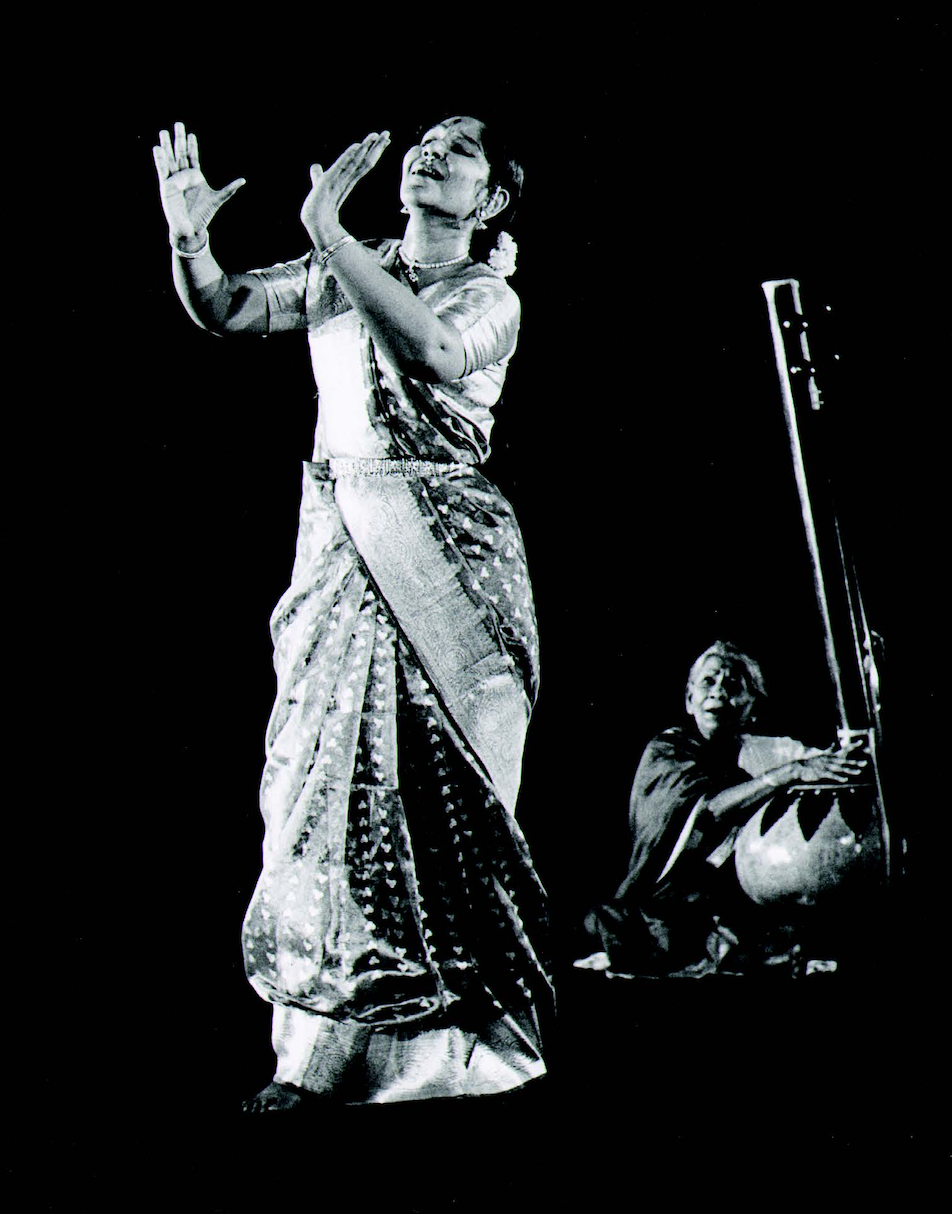
Bollywood is busting out all over. From the Academy Award–winning film Slumdog Millionaire and swirling-armed flash mobs populating Times Square to ankle-bell-clad couples stamping on TV shows including “So You Think You Can Dance” and “Smash,” Indian dance has found its global footing. And while fascination with exotic aspects of Asian culture has infiltrated our pop culture, it was Balasaraswati (1918–1984) who helped bring the traditional dance form international respect and recognition.
An exponent of pure bharatanatyam, Balasaraswati remained true to the ancient form and was one of the first to expand it to Western audiences—without pandering. Her traditional performances helped prove the historical and artistic value of the dance, contributing to the current status of bharatanatyam as a fine art. “Bala was able to transcend biases and integrate her art into the mainstream,” says Hari Krishnan, who teaches dance at Wesleyan University and directs the Toronto-based inDANCE troupe. “Her work is subtle, poetic and a sophisticated way of celebrating art and life—something that must be remembered today.”
Born in South India, a seventh-generation descendant of musicians and dancers, Bala—as she’s known to fans—was encouraged by her mother (a singer/musician) to dance. Bala trained with various teachers starting at age 4, studying mime, gestures, improvisation and music, as well as language and philosophy. And when she made her debut performance at age 7, audiences were astounded.
“Bala was pivotal in the history of Indian dance. She embodied indigenous talent and had a kind of power, a groundedness within the form, enabling her to negotiate multiple crosscurrents.”
—Ananya Chatterjea
Though bharatanatyam originated in the temples, by the early 20th century it had been condemned. Western colonialists looked with disdain at the ritual dances and practices linked to worship, and a movement rose to abolish them. The artists who worked to preserve bharatanatyam were of two camps—those who thought to reform and contemporize the dance, and those who chose a nationalist and traditionalist route.
Bala was a purist, and she continued to perform the repertoire as generations had done before. A master of footwork, she focused almost exclusively on gesture, torso movement and facial expressions. With her arms raised and palms out, she was praised for bringing out poetic imagery of themes dealing with a human striving for union with the divine.
“It’s not about lines or craft. What fires up her dancing is an understanding of the human sentiment,” says Ananya Chatterjea, the director of dance at the University of Minnesota, who also directs Ananya Dance Theatre. “Through her love of God, she was also dancing about the love of human beings.”
As Balasaraswati’s reputation soared, a number of people advocated for international appearances. Among them was Charles Reinhart (later the American Dance Festival director), who signed her to tour for the Asia Society. Bala performed in 1962 at Jacob’s Pillow Dance Festival and at the 1963 Edinburgh Festival, and she was lauded by Martha Graham and Margot Fonteyn. Universities, including Wesleyan University, UCLA and Mills College, sponsored performances and residencies, and Bala taught American dance students from 1962 to 1981. The mid-1970s also saw the formation of Balasaraswati School of Indian Music and Dance in Berkeley, California. Bala and her daughter, Lakshmi S. Knight, headed the faculty. Though Balasaraswati died in Madras, India, (now Chennai) in 1984, Lakshmi opened and directed a Balasaraswati School of Indian Music and Dance in New Jersey until her death in 2001.
There is still a school in Chennai, where Lakshmi’s son, Aniruddha Knight, heads the facility and is the last direct inheritor of the music and dance traditions preserved in his family for nine generations. Today, the Bala Music & Dance Association, in Old Lyme, Connecticut, is led by Lakshmi’s husband Douglas Knight and facilitates performance tours.
Extra Credit
You might have seen Nakul Dev Mahajan’s energetic Bollywood choreography on Season 4 of “So You Think You Can Dance,” but are you familiar with some of the other styles of Indian dance?
- Bharatanatyam is one of the oldest Indian dance forms that originated in the temples and courts of South India. Codified in the 19th century, the artform was passed down through generations within the Devadasi tradition, in which women were dedicated to temples and trained to perform the dance as part of worship. But when the practices associated with the Devadasi system were prohibited in the colonial era, artists looked to preserve the dance. Beginning in the 1930s, the dance was brought from the temples to the proscenium stage. The style is characterized by a vast vocabulary of symbolic hand gestures (mudras), rhythmic footwork and detailed facial expressions that all convey a story. A bharatanatyam recital usually encompasses six (or more) sections and can span more than two hours without interruption. Today, the form is one of the most popular and widely performed—by both men and women—and choreographers often mix this classical form with contemporary styles.
- Kathak: A classical dance of northern India, this style began 4,000 years ago with the Kathakas, storytellers who developed the dance to emphasize their stories, rooted in mythology. The form involves quick spins and rhythmic footwork, complex gestures and theatrical facial expressions. The choreographer Akram Khan is known for blending kathak with contemporary dance.
- Odissi (or Orissi): Originating in the temples of ancient eastern India, this dance form was prohibited during the colonial era. During the Indian dance revival in the 20th century, performers studied sculptures, artwork and religious scripture to reconstruct it. This style emphasizes isolation of the head, torso and bust, and the dance moves through poses that tell a story.
- Bollywood refers to India’s Mumbai-based film industry. Generally featuring boy-meets-girl scenarios, this high-energy genre influenced by hip hop is known for lavish song and-dance numbers and spectacular costumes. As the global village becomes smaller, classical Indian dance, replete with bobbing heads, deep pliés and filigreed fingers, has made Bollywood-style dance a fixture in television, Broadway shows and film.




